The Spatiotemporal Analysis of Land Take Exemplified by Poland
Abstract
1. Introduction
2. Materials and Methods
2.1. Study Area and Data Acquisition
2.2. Research Problems and Main Methodological Assumptions
3. Results
3.1. Overwiew of Land Protection Law and Land Take in Poland
3.2. Land Take Analysis—Variability and Diverity at the Province Level
4. Discussion
5. Conclusions
Funding
Institutional Review Board Statement
Informed Consent Statement
Data Availability Statement
Acknowledgments
Conflicts of Interest
References
- Gerten, C.; Fina, S.; Rusche, K. The Sprawling Planet: Simplifying the Measurement of Global Urbanization Trends. Front. Environ. Sci. 2019, 7, 140. [Google Scholar] [CrossRef]
- van Vliet, J.; Eitelberg, D.A.; Verburg, P.H. A global analysis of land take in cropland areas and production displacement from urbanization. Glob. Environ. Chang. 2017, 43, 107–115. [Google Scholar] [CrossRef]
- Bielecka, E. GIS Spatial Analysis Modeling for Land Use Change. A Bibliometric Analysis of the Intellectual Base and Trends. Geosciences 2020, 10, 421. [Google Scholar] [CrossRef]
- European Environment Agency (EEA). Land Take in Europe. Indicator Assessment. Available online: https://www.eea.europa.eu/data-and-maps/indicators/land-take-3/assessment (accessed on 28 May 2022).
- Lambin, E.F.; Turner, B.L., II; Geist, H.; Agbola, S.; Angelsen, A.; Bruce, J.W.; Coomes, O.; Dirzo, R.; Fischer, G.; Folke, C.; et al. Our emerging understanding of the causes of land-use and -cover change. Glob. Environ. Chang. 2001, 11, 261–269. [Google Scholar] [CrossRef]
- Foley, J.A.; DeFries, R.; Asner, G.P.; Barford, C.; Bonan, G.; Carpenter, S.R.; Chapin, F.S.; Coe, M.T.; Daily, G.C.; Gibbs, H.K.; et al. Global consequences of land use. Science 2005, 309, 570–574. [Google Scholar] [CrossRef] [PubMed]
- UN Secretary-General, World Commission on Environment and Development & Brundtland Commission. Our Common Future, Brundtland Report. In Proceedings of the Report of the World Commission on Environment and Development to the Commission of the European Communities, the EC and EFTA Countries, Brussels, Belgium, 5 May 1987; World Commission on Environment and Development: Brussels, Belgium, 1987. Available online: https://sustainabledevelopment.un.org/content/documents/5987our-common-future.pdf (accessed on 30 May 2022).
- European Commission (EC). Communication from the Commission to the European Parliament, the Council, the European Economic and Social Committee and the Committee of the Regions Roadmap to a Resource Efficient Europe. COM/2011/0571. Available online: http://eur-lex.europa.eu/legal-content/EN/TXT/?uri=CELEX:52011DC0571 (accessed on 30 May 2022).
- European Commission (EC). Science for Environment Policy. In Future Brief: No Net Land Take by 2050? European Commission: Brussels, Belgium, 2016; p. 4. Available online: https://ec.europa.eu/environment/integration/research/newsalert/pdf/no_net_land_take_by_2050_FB14_en.pdf (accessed on 30 May 2022).
- European Environment Agency (EEA). Urban Sprawl in Europe: The Ignored Challenge; Report No 10/2006; Office for Official Publications of the European Communities: Luxembourg, 2006; Available online: http://www.eea.europa.eu/publications/eea_report_2006_10 (accessed on 25 November 2023).
- Schiavina, M.; Melchiorri, M.; Corbane, C.; Freire, S.; Batista e Silva, F. Built-up areas are expanding faster than population growth: Regional patterns and trajectories in Europe. J. Land Use Sci. 2022, 17, 591–608. [Google Scholar] [CrossRef]
- Seto, K.C.; Sánchez-Rodríguez, R.; Fragkias, M. The New Geography of Contemporary Urbanization and the Environment. Ann. Rev. Environ. Resour. 2010, 35, 167–194. [Google Scholar] [CrossRef]
- Calka, B.; Orych, A.; Bielecka, E.; Mozuriunaite, S. The Ratio of the Land Consumption Rate to the Population Growth Rate: A Framework for the Achievement of the Spatiotemporal Pattern in Poland and Lithuania. Remote Sens. 2022, 14, 1074. [Google Scholar] [CrossRef]
- Bielecka, E.; Jenerowicz, A.; Pokonieczny, K.; Borkowska, S. Land Cover Changes and Flows in the Polish Baltic Coastal Zone: A Qualitative and Quantitative Approach. Remote Sens. 2020, 12, 2088. [Google Scholar] [CrossRef]
- Wiatkowska, B.; Słodczyk, J.; Stokowska, A. Spatial-Temporal Land Use and Land Cover Changes in Urban Areas Using Remote Sensing Images and GIS Analysis: The Case Study of Opole, Poland. Geosciences 2021, 11, 312. [Google Scholar] [CrossRef]
- Noszczyk, T.; Rutkowska, A.; Hernik, J. Exploring the land use changes in Eastern Poland: Statistics-based modelling. Hum. Ecol. Risk Assess. Int. J. 2020, 26, 255–282. [Google Scholar] [CrossRef]
- Kurowska, K.; Marks-Bielska, R.; Bielski, S.; Aleknavičius, A.; Kowalczyk, C. Geographic Information Systems and the Sustainable Development of Rural Areas. Land 2021, 10, 6. [Google Scholar] [CrossRef]
- Bołtryk, P. Conversion of agricultural land into non-agricultural land in Poland. Ekon. Sr.-Econ. Environ. 2020, 72, 40–57. [Google Scholar] [CrossRef]
- Murray, A.T.; Church, R.L.; Pludow, B.A.; Stine, P. Advancing contiguous environmental land allocation analysis, planning and modelling. Journal of Land Use. Science 2022, 17, 572–590. [Google Scholar] [CrossRef]
- Decoville, A.; Schneider, M. Can the 2050 zero land take objective of the EU be reliably monitored? A comparative study. J. Land Use Sci. 2015, 11, 331–349. [Google Scholar] [CrossRef]
- Kaliszewski, A.; Jabłoński, M. Is It Possible for Poland to Achieve the Policy Goal of 33% Forest Cover by Mid-Century? Sustainability 2022, 14, 6541. [Google Scholar] [CrossRef]
- Ragnarsdóttir, K.V.; Banwart, S.A. (Eds.) Soil: The Life Supporting Skin of Earth: A Book on Soil for Secondary School Students; University of Sheffield: Sheffield, UK; University of Iceland: Reykjavík, Iceland, 2015; Available online: http://esdac.jrc.ec.europa.eu/projects/SoilTrec/Documents/SoilTrEC_SoilSchoolBook_FINAL.pdf (accessed on 1 June 2022).
- Haines-Young, R.; Potschin, M. The links between biodiversity, ecosystem services and human well-being. In Ecosystem Ecology: A New Synthesis; BES Ecological Reviews Series, Raffaelli, D., Frid, C., Eds.; Cambridge University Press: Cambridge, UK, 2010. [Google Scholar]
- Wiśniewski, L.Ł.; Rudnicki, R.; Chodkowska-Miszczuk, J. What non-natural factors are behind the underuse of EU CAP funds in areas with valuable habitats? Land Use Policy 2021, 108, 105574. [Google Scholar] [CrossRef]
- Węcławowicz, G.; Bański, J.; Degórski, M.; Komornicki, T.; Korcelli, P.; Śleszyński, P. Spatial Organization of Poland at the Beginning of the 21st Century; Monografie, 6; IGiZP Polish Academy of Sciences: Warszawa, Poland, 2006. [Google Scholar]
- Jhariya, M.K.; Banerjee, A.; Meena, R.S.; Yadav, D.K. Agriculture, Forestry and Environmental Sustainability: A Way Forward, In Sustainable Agriculture, Forest and Environmental Management; Jhariya, M., Banerjee, A., Meena, R., Yadav, D., Eds.; Springer Nature: Singapore, 2019; pp. 1–29. [Google Scholar] [CrossRef]
- Bański, J.; Kamińska, W. Trends for agricultural land-use in the CEECs following the collapse of the Eastern Bloc. Land Use Policy 2021, 112, 105794. [Google Scholar] [CrossRef]
- Frédéric, S. EU Commission Unveils ‘European Green Deal’: The Key Points. Available online: http://www.euractiv.com (accessed on 4 June 2022).
- Ustaoglu, E.B.; Williams, B. Determinants of urban expansion and agricultural land conversion in 25 EU countries. Environ. Manag. 2017, 60, 717–746. [Google Scholar] [CrossRef]
- Roszkowska-Mądra, B. Analiza zmian użytkowania gruntów rolnych w Polsce po 1990 roku. In Instytucjonalne i Strukturalne aspekty Rozwoju Rolnictwa i Obszarów Wiejskich. Księga Poświęcona Pamięci dr Hab. Adama Sadowskiego Profesora Uniwersytetu w Białymstoku; Przygodzka, R., Gruszewska, E., Eds.; Wydawnictwo Uniwersytetu w Białymstoku: Białystok, Poland, 2020; pp. 183–199. [Google Scholar]
- GUS. Statistical Yearbook of the Republic of Poland; Główny Urząd Statystyczny, Zakład Wydawnictw Statystycznych: Warsaw, Poland, 2021. [Google Scholar]
- GUS—Bank Danych Lokalnych. Available online: https://bdl.stat.gov.pl/bdl/start# (accessed on 20 October 2023).
- Czyż, T. Metoda wskaźnikowa w geografii społeczno-ekonomicznej. Rozw. Reg. Polityka Reg. 2016, 34, 9–19. [Google Scholar]
- Werner, P.A.; Kaleyeva, V.; Porczek, M. Urban Sprawl in Poland (2016–2021): Drivers, Wildcards, and Spatial Externalities. Remote Sens. 2022, 14, 2804. [Google Scholar] [CrossRef]
- Moran, P. Notes on continuous stochastic phenomena. Biometrika 1950, 37, 17–23. [Google Scholar] [CrossRef]
- Act on 26 October of 1971 on Agricultural, Forest Land Protection and recultivation. J. Laws 1971, 27, 249.
- Act of 3 February 1995 on the Protection of Agricultural Land and Forest. J. Laws 2017. 1161 as amended.
- Act of 27 March 2003 on Spatial Planning and Management. J. Laws 2003, 80, 717.
- Kwartalnik-Pruc, A. Exclusion of Land from Agricultural and Forestry Production. Practical Problems of the Procedure. Geomat. Environ. Eng. 2011, 5, 69–77. [Google Scholar]
- Noszczyk, T. Land Use Change Monitoring as a Task of Local Government Administration in Poland. J. Ecol. Eng. 2018, 19, 170–176. [Google Scholar] [CrossRef] [PubMed]
- Śleszyński, P.; Kowalewski, A.; Markowski, T.; Legutko-Kobus, P.; Nowak, M. The Contemporary Economic Costs of Spatial Chaos: Evidence from Poland. Land 2020, 9, 214. [Google Scholar] [CrossRef]
- Prus, B. Trends of Agricultural and Forest Land Use Changes in Poland. Acta Sci. Pol. Geod. Descr. Terrarum 2012, 11, 27–40. [Google Scholar]
- Kurowska, K.; Kryszk, H.; Marks-Bielska, R.; Mika, M.; Leń, P. Conversion of agricultural and forest land to other purposes in the context of land protection: Evidence from Polish experience. Land Use Policy 2020, 95, 104614. [Google Scholar] [CrossRef]
- Mackiewicz, B.; Motek, P. Wyłączenia gruntów rolnych z produkcji rolnej a dochody gmin z podatku od nieruchomości. Rozw. Reg. Polityka Reg. 2014, 28, 69–77. [Google Scholar] [CrossRef]
- Świdyński, J. Use and Protection of Agricultural Land in Poland, Russia and Ukraine. Zesz. Nauk. Szkoły Głównej Gospod. Wiej. W Warszawie. Probl. Rol. Swiat. 2016, 16, 344–350. [Google Scholar]
- Bąk, M.; Abramowicz, D. Zmiany kierunków użytkowania gruntów ze szczególnym uwzględnieniem użytków rolnych w miastach powiatu poznańskiego w latach 2010 i 2020. Rozw. Reg. Polityka Reg. 2021, 57, 129–145. [Google Scholar] [CrossRef]
- Marquard, E.; Bartke, S.; Gifreu i Font, J.; Humer, A.; Jonkman, A.; Jürgenson, E.; Marot, N.; Poelmans, L.; Repe, B.; Rybski, R.; et al. Land Consumption and Land Take: Enhancing Conceptual Clarity for Evaluating Spatial Governance in the EU Context. Sustainability 2020, 12, 8269. [Google Scholar] [CrossRef]
- Bielecka, E.; Jenerowicz, A. Intellectual Structure of CORINE Land Cover Research Applications in Web of Science: A Europe-Wide Review. Remote Sens. 2019, 11, 2017. [Google Scholar] [CrossRef]
- Bielecka, E.; Calka, B.; Dukaczewski, D. Towards inclusive and sustainable urbanization. Case study of land use efficiency in Poland. In Proceedings of the 8th International Conference on Cartography and GIS, Nessebar, Bulgaria, 14–19 June 2021; Bandrova, T., Konecny, M., Marinova, S., Eds.; Bulgarian Cartographic Association: Sofia, Bulgaria, 2021; Volume 2, pp. 17–24. [Google Scholar]
- Śleszyński, P. Oszacowanie wyłączeń gruntów rolnych z produkcji rolnej w Polsce. Stud. BAS 2023, 1, 21–45. Available online: https://studiabas.sejm.gov.pl (accessed on 4 November 2022). [CrossRef]
- Schmidt-Traub, G.; Kroll, C.; Teksoz, K.; Durand-Delacre, D.; Sachs, J.D. National baselines for the Sustainable Development Goals assessed in the SDG Index and Dashboards. Nat. Geosci. 2017, 10, 547–555. [Google Scholar] [CrossRef]
- Leśniewska-Napierała, K.; Nalej, M.; Napierała, T. The Impact of EU Grants Absorption on Land Cover Changes—The Case of Poland. Remote Sens. 2019, 11, 2359. [Google Scholar] [CrossRef]
- Nadolny, M. Pomiar poziomu koncentracji potencjału rozwojowego regionów w Polsce: Wartość i dynamika w latach 2010-2017 oraz prognoza do roku 2020. Biul. KPZK PAN 2019, 273, 44–58. [Google Scholar]
- KPZK2030. Uchwała Nr 239 Rady Ministrów z Dnia 13 Grudnia 2011 r. w Sprawie Przyjęcia Koncepcji Przestrzennego Zagospodarowania Kraju 2030. MONITOR POLSKI 2012, item. 252. Available online: https://isap.sejm.gov.pl/isap.nsf/DocDetails.xsp?id=WMP20120000252 (accessed on 10 November 2023).
- Kłos, K. Analiza Przekształcenia Gruntów Rolnych i Leśnych na Inne Cele w Kontekście Ochrony Gruntów z Uwzględnieniem Aspektów Przestrzennych i Prawnych. Master’s Thesis, Militari University of Technology, Warszaw, Poland, 6 July 2022. [Google Scholar]
- Wolff, S.; Schrammeijer, E.A.; Schulp, C.J.E.; Verburg, P.H. Meeting global land restoration and protection targets: What would the world look like in 2050? Glob. Environ. Chang. 2018, 52, 259–272. [Google Scholar] [CrossRef]
- Debonne, N.; Bürgi, M.; Diogo, V.; Helfenstein, J.; Herzog, F.; Levers, C.; Mohr, F.; Swart, R.; Verburg, P. The geography of megatrends affecting European agriculture. Glob. Environ. Chang. 2022, 75, 102551. [Google Scholar] [CrossRef]

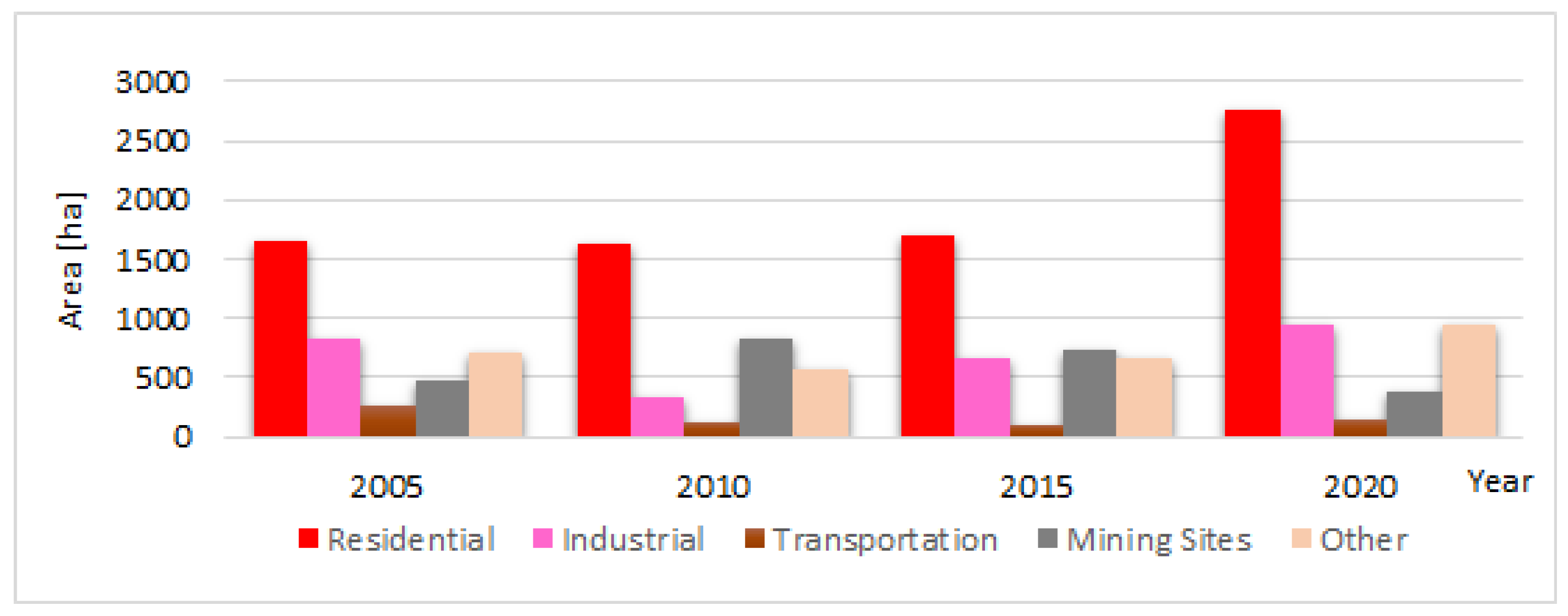
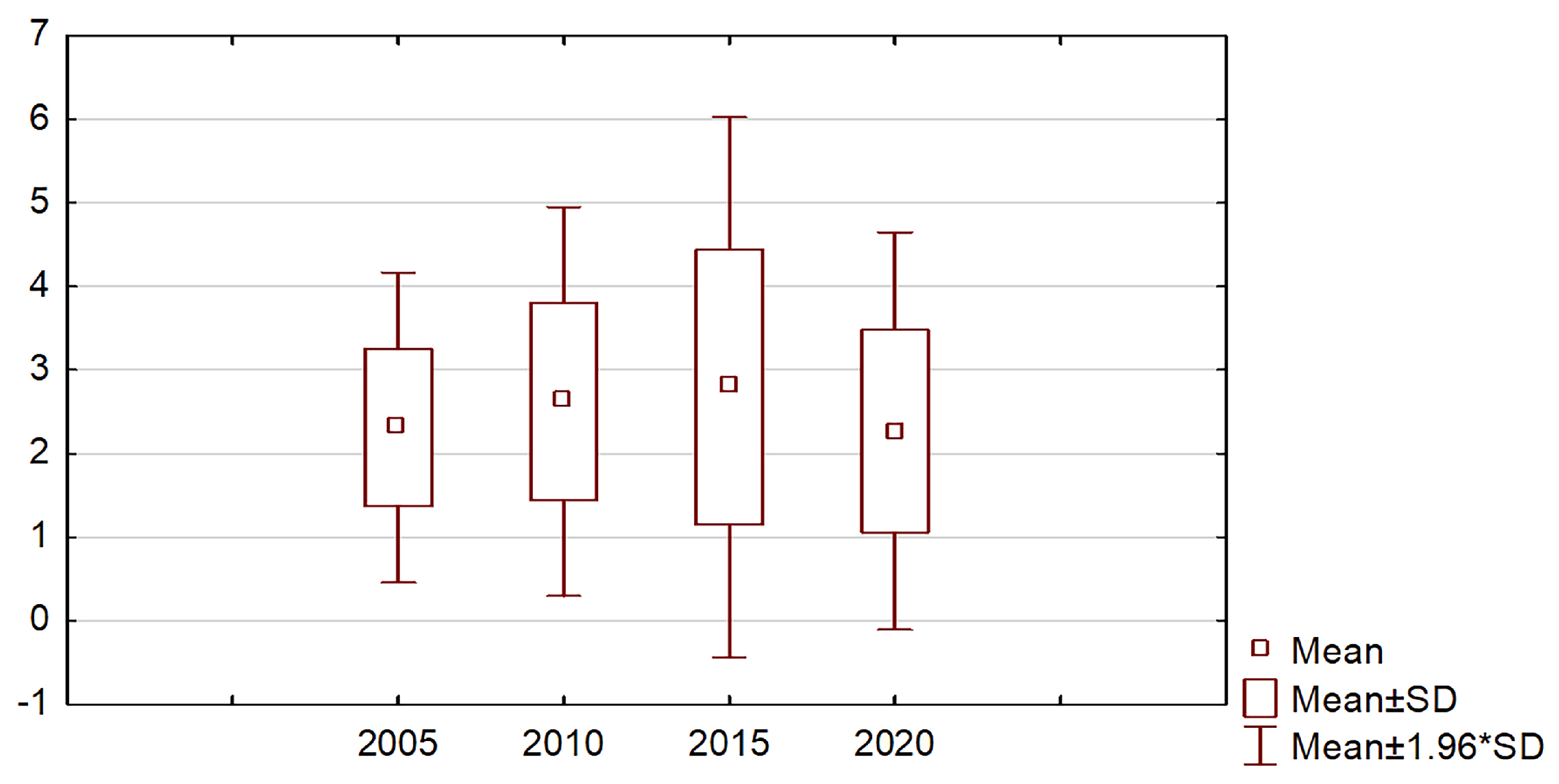
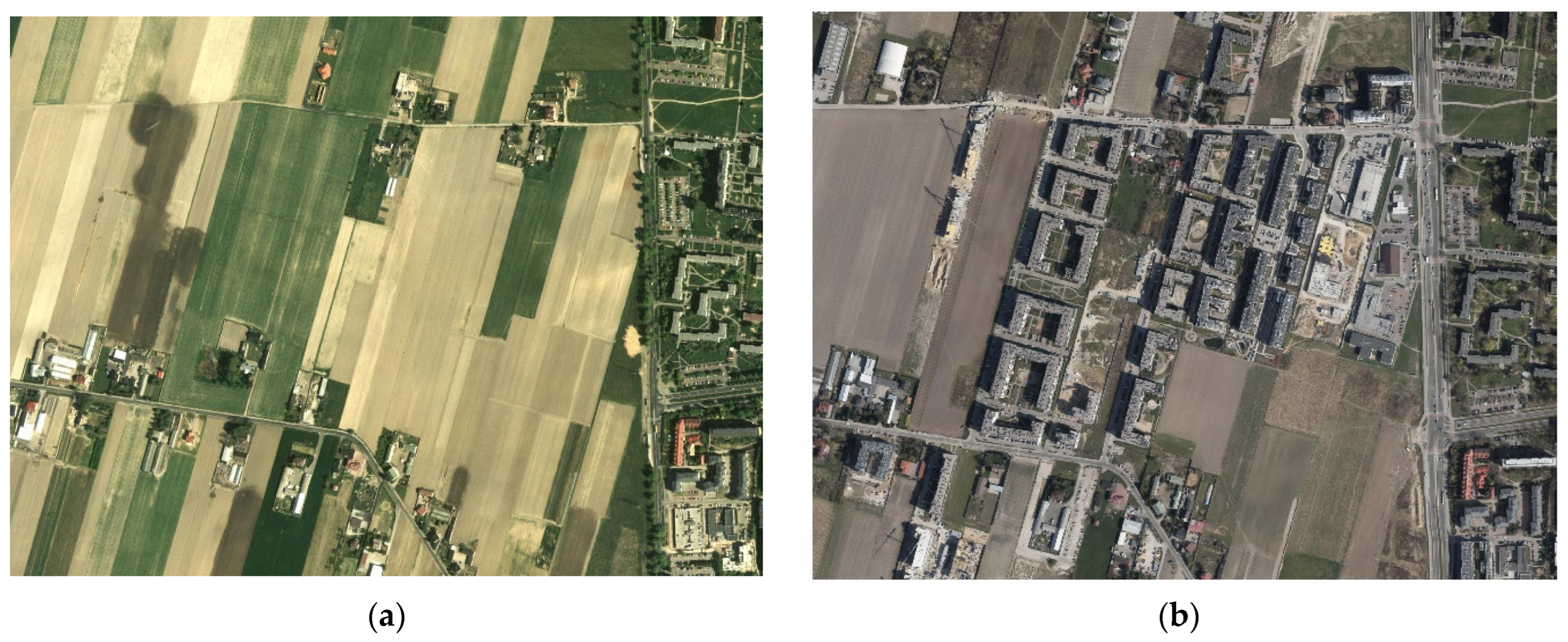
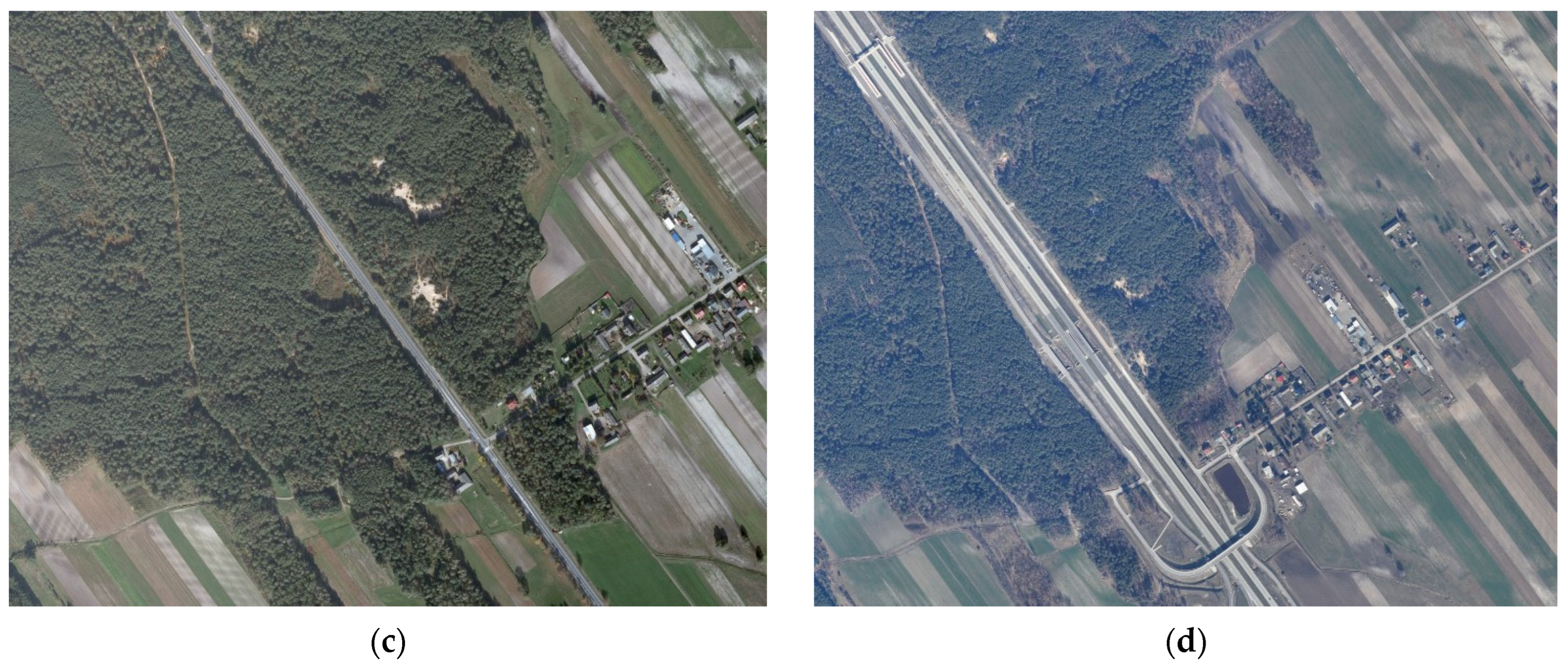
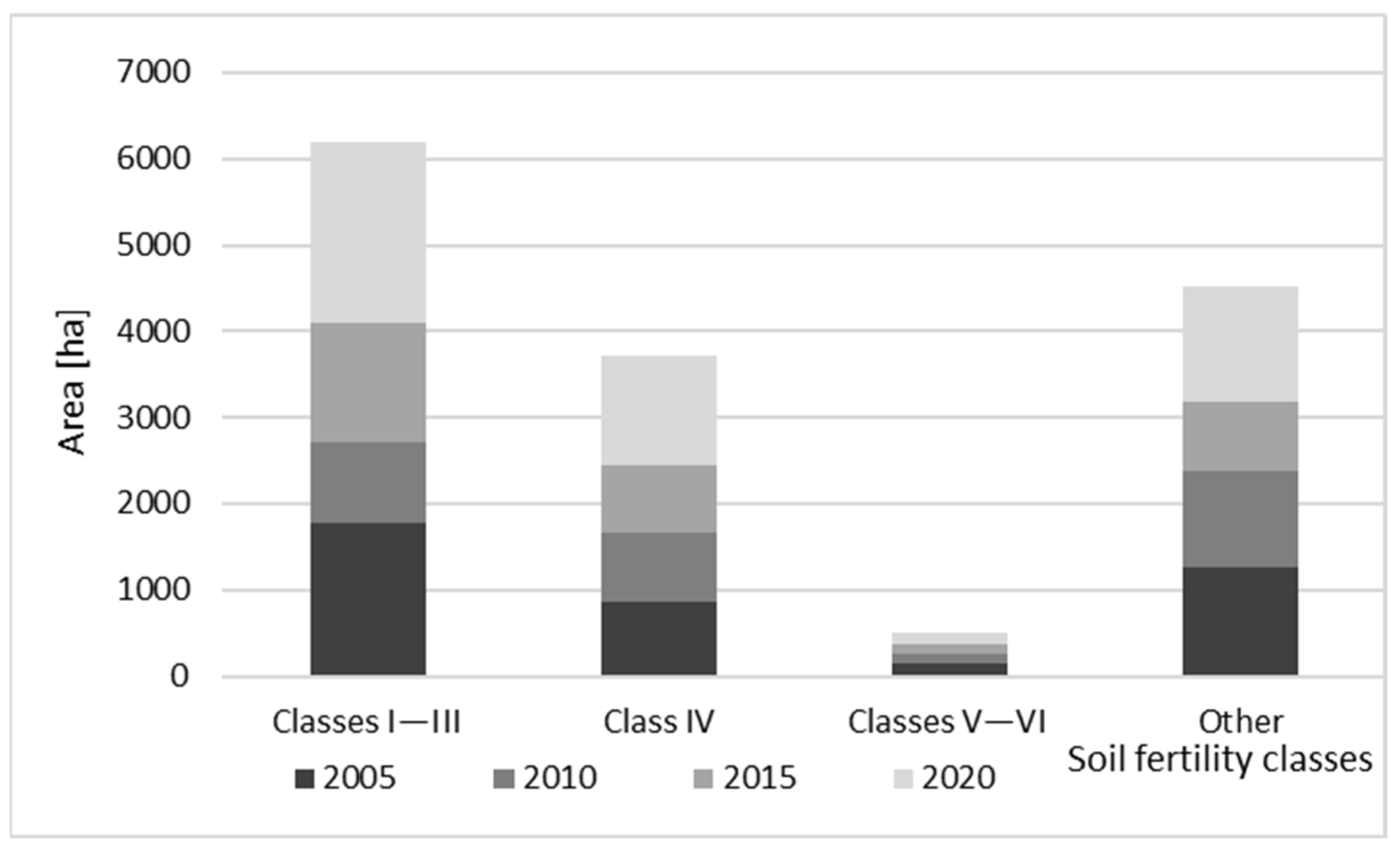
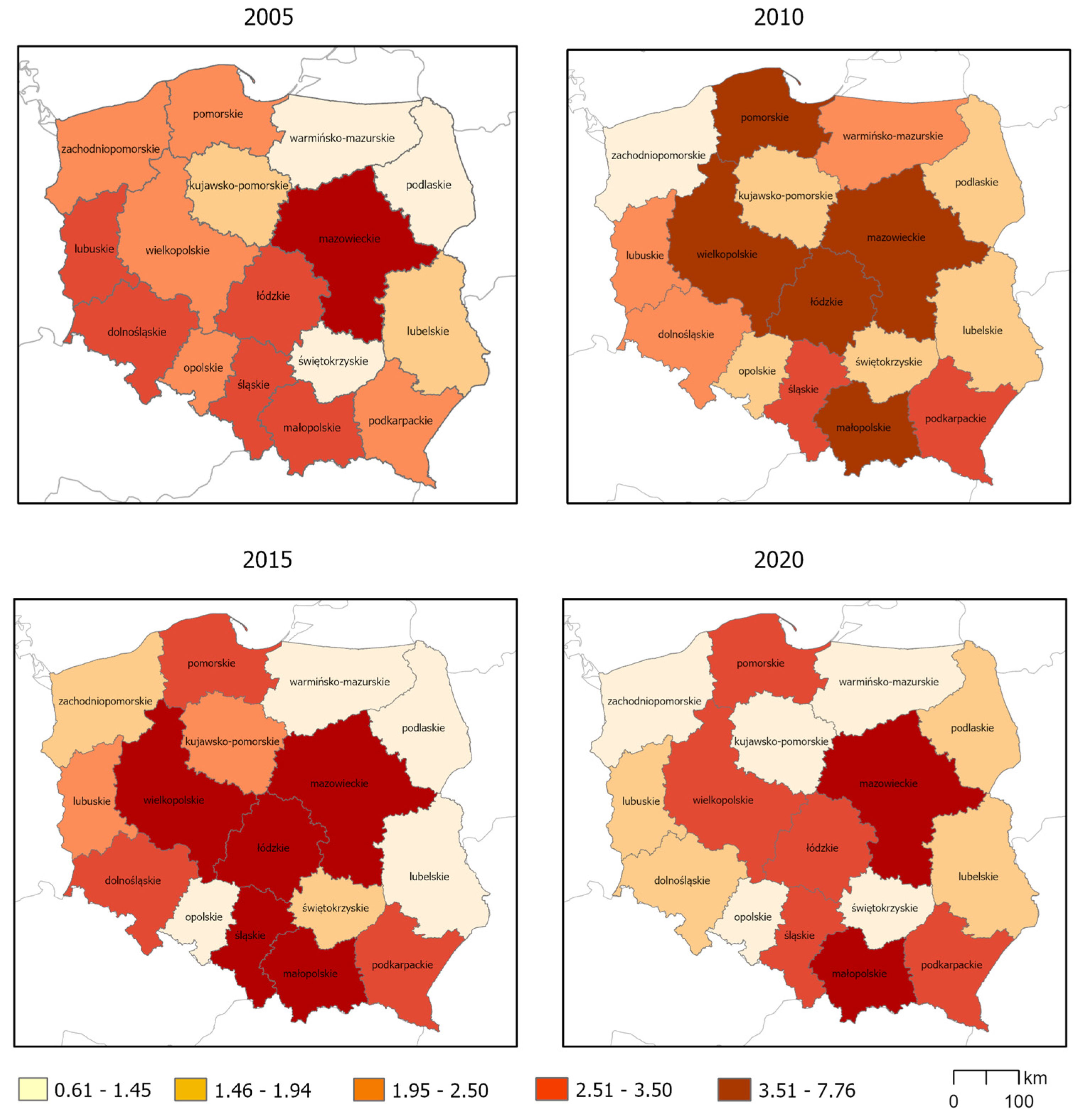
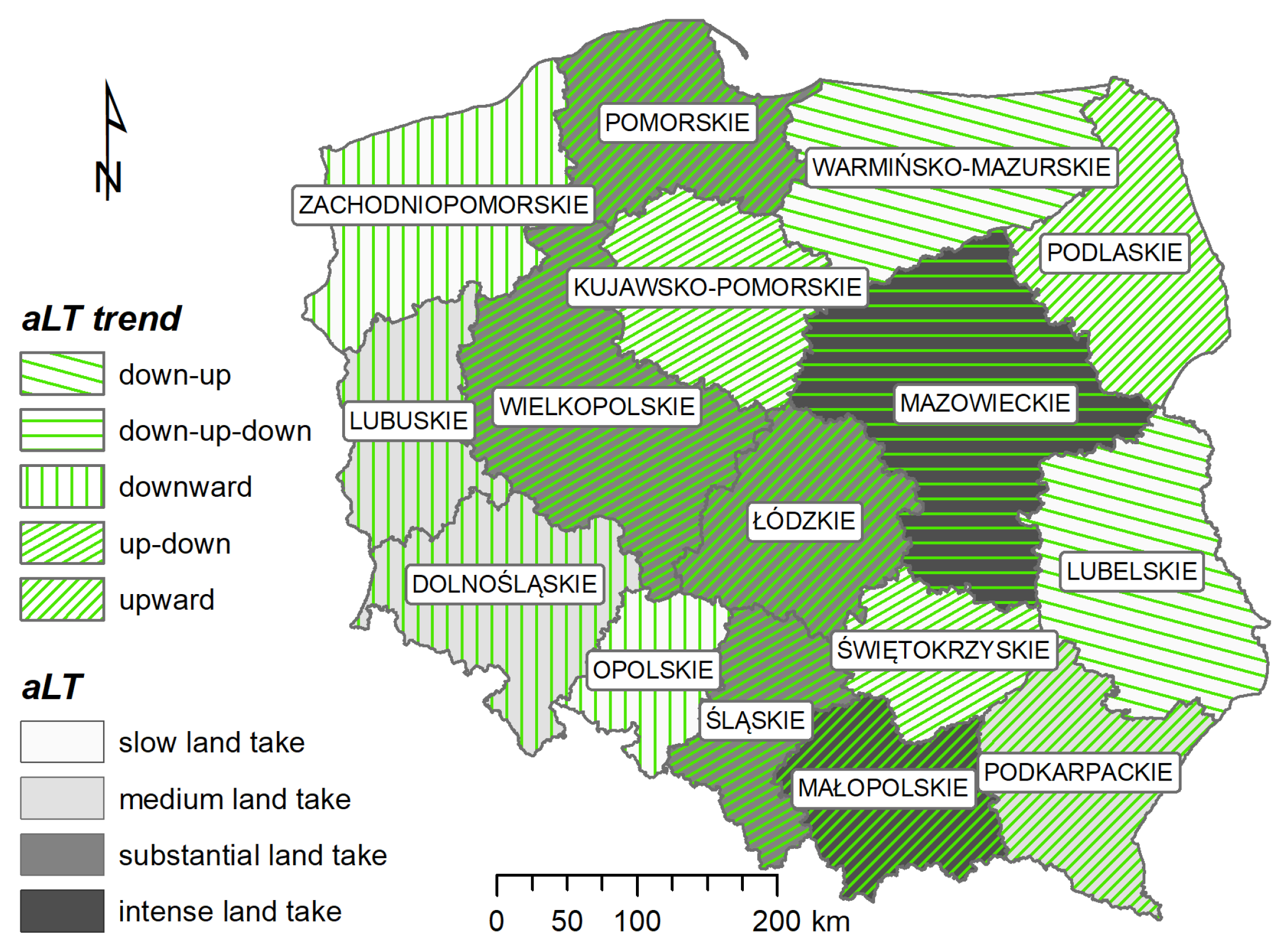
| Agricultural Land Intended for Other Purposes in ha (%) | Forest Intended for Other Purposes in ha (%) | |||||||
|---|---|---|---|---|---|---|---|---|
| Province/Year | 2005 | 2010 | 2015 | 2020 | 2005 | 2010 | 2015 | 2020 |
| Poland | 360,360 (1.89) | 395,504 (2.09) | 402,576 (2.15) | 308,075 (1.64) | 23,370 (0.26) | 30,170 (0.33) | 37,041 (0.39) | 37,173 (0.39) |
| Dolnośląskie | 34,073 (2.83) | 29,883 (2.50) | 24,656 (2.08) | 12,766 (1.08) | 467 (0.08) | 1043 (0.17) | 452 (0.07) | 1524 (0.25) |
| Kujawsko-Pomorskie | 14,130 (1.19) | 18,725 (1.59) | 14,098 (1.21) | 13,229 (1.13) | 617 (0.15) | 932 (0.22) | 1140 (0.27) | 250 (0.06) |
| Lubelskie | 26,853 (1.50) | 17,582 (0.99) | 22,283 (1.27) | 26,658 (1.51) | 1038 (0.18) | 1244 (0.22) | 903 (0.15) | 1336 (0.23) |
| Lubuskie | 13,849 (2.41) | 10,512(1.84) | 10,823 (1.92) | 7741 (1.36) | 555 (0.08) | 1557 (0.22) | 602 (0.08) | 322 (0.05) |
| Łódzkie | 27,129 (2.07) | 32,477 (2.50) | 23,862 (1.86) | 26,834 (2.09) | 1533 (0.40) | 3659 (0.94) | 5412 (1.38) | 3541 (0.90) |
| Małopolskie | 24,946 (2.66) | 36,939 (3.94) | 52,624 (5.70) | 32,186 (3.51) | 1638 (0.37) | 861 (0.20) | 5570 (1.26) | 5319 (1.21) |
| Mazowieckie | 79,524 (3.22) | 66,746 (2.73) | 73,330 (3.07) | 53,616 (2.22) | 6280 (0.79) | 6214 (0.77) | 10,269 (1.24) | 10,797 (1.29) |
| Opolskie | 9715 (1.60) | 6865 (1.14) | 9035 (1.50) | 4177 (0.70) | 859 (0.33) | 232 (0.09) | 598 (0.23) | 524 (0.20) |
| Podkarpackie | 20,093 (2.06) | 19,836 (2.06) | 19,049 (2.03) | 21,073 (2.19) | 811 (0.12) | 2980 (0.44) | 3055 (0.45) | 3955 (0.57) |
| Podlaskie | 5831 (0.47) | 9765 (0,80) | 16,642 (1.37) | 15,335 (1.26) | 487 (0.08) | 442 (0.07) | 767 (0.12) | 963 (0.15) |
| Pomorskie | 13,507 (1.44) | 25,863 (2.78) | 26,585 (2.89) | 25,248 (2.75) | 2039 (0.30) | 1863 (0.27) | 1682 (0.25) | 1247 (0.18) |
| Ślaskie | 16,924 (2.59) | 16,637 (2.58) | 12,867 (2.05) | 9747 (1.56) | 953 (0.24) | 2981 (0.75) | 1358 (0.34) | 2698 (0.67) |
| Świętokrzyskie | 6880 (0.91) | 10,813 (1.43) | 8436 (1.12) | 6522 (0.86) | 758 (0.23) | 668 (0.20) | 807 (0.24) | 413 (0.12) |
| Warmińsko-Mazurskie | 10,335 (0.77) | 13,816 (1.04) | 22,791 (1.74) | 16,038 (1.22) | 3471 (0.46) | 658 (0.09) | 443 (0.06) | 141 (0.02) |
| Wielkopolskie | 37,313 (1.91) | 62,775 (3.22) | 56,566 (2.92) | 36,838 (1.39) | 1043 (0.13) | 4204 (0.54) | 2378 (0.30) | 2914 (0.37) |
| Zachodniopomorskie | 19,258 (1.69) | 16,270 (1.44) | 8929 (0.80) | 10,067 (0.89) | 821 (0.10) | 632 (0.08) | 1605 (0.19) | 1229 (0.15) |
| aLT2005–2020 Range | aLT2005–2020 Value | Description |
|---|---|---|
| aLT2005–2020 − 0.5 × STD | 0 < aLT2005–2020 ≤ 1.93 | slow land take |
| aLT2005–2020 + 0.25 × STD | 1.94 < aLT2005–2020 ≤ 2.80 | medium land take |
| aLT2005–2020 + 0.75 × STD | 2.81 < aLT2005–2020 ≤ 3.39 | substantial land take |
| aLT2006–2020 + 0.75 × STD | aLT2006–2020 > 3.40 | intense land take |
| Province Name/ Reference Year | aLT2005 2005 | aLT2010 2010 | aLT2015 2015 | aLT2020 2020 |
|---|---|---|---|---|
| Dolnośląskie | 3.21 | 2.95 | 2.39 | 1.47 |
| Kujawsko-Pomorskie | 1.49 | 2.02 | 1.66 | 1.34 |
| Lubelskie | 1.79 | 1.29 | 1.53 | 1.85 |
| Lubuskie | 2.78 | 2.25 | 2.19 | 1.54 |
| Łódzkie | 2.66 | 3.72 | 3.52 | 3.25 |
| Małopolskie | 3.34 | 4.57 | 7.76 | 5.27 |
| Mazowieckie | 4.37 | 3.83 | 4.77 | 3.85 |
| Opolskie | 2.11 | 1.34 | 1.90 | 0.98 |
| Podkarpackie | 2.36 | 2.73 | 2.73 | 2.98 |
| Podlaskie | 0.61 | 0.95 | 1.63 | 1.54 |
| Pomorskie | 1.98 | 3.48 | 3.58 | 3.36 |
| Śląskie | 3.31 | 3.92 | 2.85 | 2.68 |
| Świętokrzyskie | 1.22 | 1.76 | 1.47 | 1.05 |
| Warmińsko-Mazurskie | 1.44 | 1.31 | 2.10 | 1.43 |
| Wielkopolskie | 2.23 | 4.11 | 3.53 | 2.51 |
| Zachodniopomorskie | 2.10 | 1.77 | 1.16 | 1.21 |
| Country average | 2.32 | 2.63 | 2.80 | 2.27 |
Disclaimer/Publisher’s Note: The statements, opinions and data contained in all publications are solely those of the individual author(s) and contributor(s) and not of MDPI and/or the editor(s). MDPI and/or the editor(s) disclaim responsibility for any injury to people or property resulting from any ideas, methods, instructions or products referred to in the content. |
© 2024 by the author. Licensee MDPI, Basel, Switzerland. This article is an open access article distributed under the terms and conditions of the Creative Commons Attribution (CC BY) license (https://creativecommons.org/licenses/by/4.0/).
Share and Cite
Elzbieta, B. The Spatiotemporal Analysis of Land Take Exemplified by Poland. Sustainability 2024, 16, 1059. https://doi.org/10.3390/su16031059
Elzbieta B. The Spatiotemporal Analysis of Land Take Exemplified by Poland. Sustainability. 2024; 16(3):1059. https://doi.org/10.3390/su16031059
Chicago/Turabian StyleElzbieta, Bielecka. 2024. "The Spatiotemporal Analysis of Land Take Exemplified by Poland" Sustainability 16, no. 3: 1059. https://doi.org/10.3390/su16031059
APA StyleElzbieta, B. (2024). The Spatiotemporal Analysis of Land Take Exemplified by Poland. Sustainability, 16(3), 1059. https://doi.org/10.3390/su16031059







